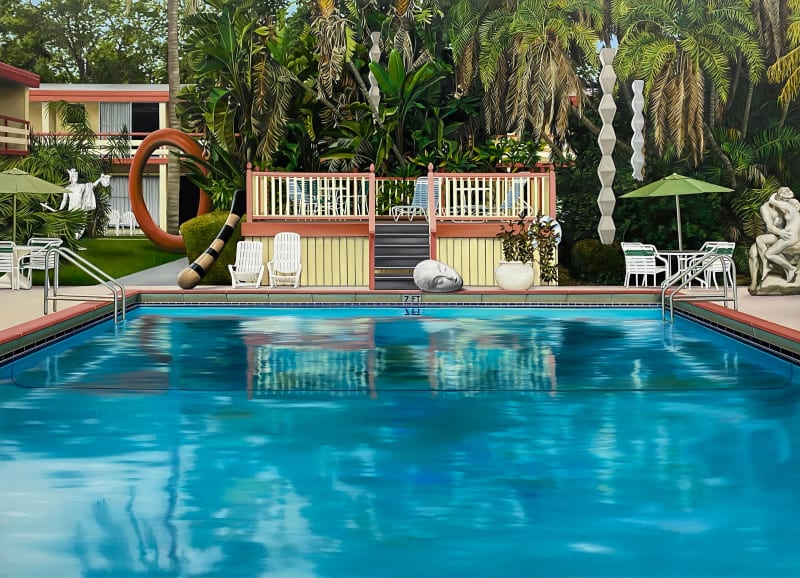We seem to be standing on the edge of a swimming pool looking across to its far side. Or perhaps we are in it, sitting in the shallow end (there is a sign on the other side indicating the depth over there is 7 foot). It is an outdoor pool, with buildings from the house it belongs to off to the left. The house is sited in a lush tropical landscape, and behind a raised terrace, trees proliferate and interweave with each other. Outdoor furniture is dotted around the pool as are various sculptures. Off to the right Rodin’s lovers embrace near the metal stair you use to climb out. In the foliage three of Brancusi’s Endless Columns sprout. The pool looks like it is waiting. Waiting for you to make your move and dive into whatever the next moment in this series of overloaded present tenses holds.
The scene is from a painting by Alina Grasmann, titled ‘Bestiary (Room 8)’. A related painting, ‘Untitled (Room 8)’ seems to be of the same location but from a different viewpoint, from up on the seated terrace of the first painting. Two clocks that have seemingly escaped from Salvador Dalí’s painting ‘The Persistence of Memory’ are draped over a lounge-seat and a wooden rail. Each floppy melted camembert of a clock points to 2.22, a time that is seen in other clocks that appear in Grasmann’s series ‘Florida Räume’ (Florida Rooms). Time seems to have frozen in these paintings but also expanded to allow us to take a different seat in the same scene without the clock ticking forward. That moment of frozen time connects the six paintings, three large-format, three small-format, that make up Grasmann’s exhibition at Niru Ratnam titled ‘Florida Räume’ (Florida rooms). Grasmann conceives of each pair as a ‘room’ or a distinct space that is perceived from two different vantage points. The ‘rooms’ lead to or look out on other ones, so it is possible theoretically for the viewer to ‘walk’ from one to the other
The titles of each painting invoke the writings of the Argentinian fabulist author Julio Cortázar. ‘Bestiary’, the title of one of the paintings is a short story by Cortázar where the protagonist spends the summer at her Aunts house, which seems a normal bourgeois residence aside from the fact that a large tiger roams the premises. Servants and family members have to constantly report which room or parts of the garden to avoid. The situation is of two different realities, a normal one and one where a tiger roams incongruously free, that are layered on top of each other. Aside from her titles Grasmann does not otherwise reference Cortázar, but the sense of apprehensive oddness as well as overlapping versions of the present that permeates Cortázar’s writings infuses Grasmann’s paintings.
In ‘There but where, how (Room 10)’ we are in room that looks out onto the foliage seen in ‘Bestiary (Room 8)’, with the three Brancusi’s Columns seen from the other side. Their appearance, along with the other art historical remnants that float into the scenes are a bit like Cortázar’s tiger; objects that really should not be in this particular moment but that have drifted in from another dimension and insist on not leaving. There are a series of realities here which are overlapped into a single moment of time, an effect heightened by Grasmann’s virtuso hyperrealistic paintwork. Realism is deployed to depict a multiverse of realities.
Motifs such as the Brancusi sculpture recur but sometimes in different forms; a small note stuck to the window in ‘There but where, how (Room 10)’ shows David Hockney’s ‘A Bigger Splash’. Hockney’s swimming pool imagery escapes its own frame, shimmering on the wallpaper in the cafe in ‘Untitled (Room 10)’. A neon sign in that work reads ‘ALWAYS OPEN’ but the cafe is deserted; perhaps it is more that each moment we inhabit is always more open than we think, to the past, to the future, to innumerable other presents that haunt it. As T.S.Eliot wrote in ‘Four Quartets’, realism is not what you might quite expect:
“‘Go, go, go, said the bird: human kind
Cannot bear very much reality.
Time past and time future
What might have been and what has been
Point to one end, which is always present.”
Alina Grasmann (b.1989, Munich. Live and works in Munich, Germany) is a realist painter whose large-scale, site-specific series blur fact and fiction. Her works are inspired by architecture, literature and film. Each series contains about 10–15 paintings, all based on specific locations. Grasmann researches places and then visits them in real life, recording her experiences and the atmosphere through photographs. Drawn to the narratives of each place, she compares the reality and sensation of the place with the way she imagined it would be, then makes interventions by changing or adding objects, or erasing parts. Rather than illustrating existing myths about a place, she aims to create space for association so new stories emerge.
Grasmann lives and works in Munich, Germany, having studied at the Academy of Fine Arts in Munich and at the University of Applied Arts in Vienna. Grasmann’s work has been exhibited at several museums in Germany, including Kunstverein München, Galerie der Künstler, and Hubert Burda Media. This is her debut solo exhibition in the UK.
